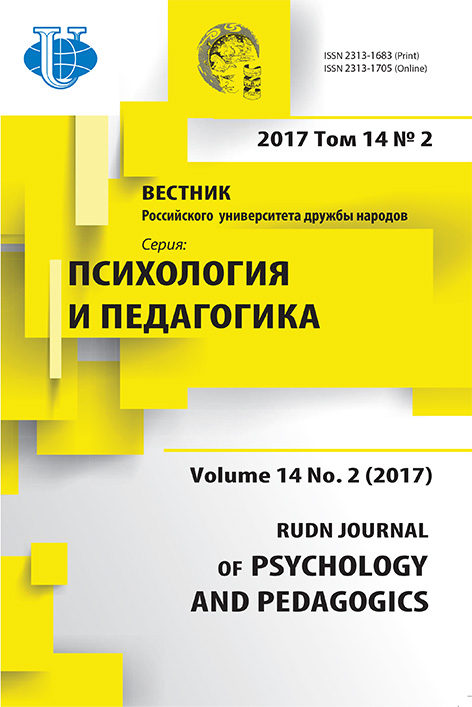CULTURAL AND VALUE ORIENTATIONS OF RUSSIAN, BURYAT, AND MONGOLIAN STUDENTS
- Authors: Dugarova T.T.1, Badiev I.V1
-
Affiliations:
- Buryat State University
- Issue: Vol 14, No 2 (2017)
- Pages: 190-200
- Section: Articles
- URL: https://journals.rudn.ru/psychology-pedagogics/article/view/15979
- DOI: https://doi.org/10.22363/2313-1683-2017-14-2-190-200
Cite item
Full Text
Abstract
The article discusses the results of empirical studies of cultural and value orientations Russian (Buryat) and Mongolian students. The sample includes humanities students of Ulan-Ude (Russian Federation) universities ( n = 388) and Ulan Bator (Mongolia) universities ( n = 176). In the present empirical research the following diagnostic methods were used: J. Townsend’s “Cultural andValue Orientations Test” adapted by L.G. Pochebut and R. Inglehart’ scale in M.S. Yanitskiy modification. The analysis revealed that the dominant cultural type of Buryat and Mongolian young people is the modern culture type. There are ethnic differences in adherence to traditional and dynamically developing culture: Buryat students are more committed to the traditional and modern culture, and less focused on dynamically developing culture; Russian students are more focused on traditional and dynamically developing culture and less focused on modern culture; Mongolian students are more focused on dynamically developing culture and less focused on traditional culture. The youth of Buryatia are more committed to the values of adaptation and socialization than the youth of Mongolia. The youth of Buryatia are more committed to the values of adaptation than the youth of Mongolia. There are differences in individualization values in the subsamples of students from Russia: these values are more prominent in Russians than in Buryats. Revealed differences are interpreted as ethnopsychological features of young people and are seen as potential resources of tolerance development and systemic crisis of contemporary society overcoming.
About the authors
Tuyana Ts Dugarova
Buryat State University
Author for correspondence.
Email: arovatts@mail.ru
Doctor of Psychology, Associate Professor, Associate Professor of Developmental and Educational Psychology Department of the Buryat State University (Ulan-Ude, Russia)
Smolina str., 24a, Ulan-Ude, Russia, 670000Igor V Badiev
Buryat State University
Email: bad_igor@mail.ru
lecturer of Developmental and Educational Psychology Department of the Buryat State University (Ulan-Ude, Russia)
Smolina str., 24a, Ulan-Ude, Russia, 670000References
- Belousova, E.S., & Korytova, G.S. (2014). Power of Basic Aspirations of the Personality and Their Realization in Sociocultural Setting of Educational Institutions. Tomsk State Pedagogical University Bulletin, 1(142), 105-111. (In Russ.).
- Dugarova, T.Ts. (2010). Osobennosti etnicheskogo samosoznaniya sovremennykh buryat Rossii. Doctor of psychology Thesis. Moscow: State University of Education. 189 p. (In Russ.).
- Dugarova, T. Ts. (2012). The person in the conditions of conjugation between the world of generic values and the world of cultures integration. Development of Personality, 1 (1), 188-207. (In Russ.).
- Frankl, V. (1990). Man's Search for Meaning. M.: Progress Publ. 366 p. (In Russ.).
- Ivanova, T.Yu., Leont'ev, D.A., & Rasskazova, E.I. (2016). Functions of Personality Resources in a Situation of Economic Crisis. Psychology. Journal of the Higher School of Economics, 13 (2), 323-346. (In Russ.).
- Luriya, A.R. (1982). Etapy proydennogo puti: Nauchnaya avtobiografiya. M.: MSU Publ. (In Russ.).
- Mukhina, V.S. (2010). Lichnost': Mify i Real'nost' (Al'ternativnyy vzglyad. Sistemnyy podkhod. Innovatsionnye aspekty). Moscow: Nacional'nyi knizhnyii tcentr. (In Russ.).
- Mukhina, V.S., & Dugarova, T.Ts. (2010). Mental'nye osobennosti sovremennykh buryat Rossii. Development of Personality, (2), 164-175. (In Russ.).
- Novikova, I.A. (2015). Tolerance as a factor of effective interaction in multicultural education space. Psychology of education in a multicultural space, (29), 52-62. (In Russ.).
- Novikova, I.A., & Zhambal, O. (2015).Sootnoshenie lichnostnykh chert i mezhkul'turnoi adaptatsii u mongol'skikh studentov. Lichnost' v prirode i obshchestve: Conference Proseedings (pp. 143-146). Moscow: PFUR Publ.(In Russ.).
- Orlova, K.V. (2014) Problemy mezhkul'turnoy kommunikatsii na primere akademicheskoy mobil'nosti studentov. Kommunikativnye aspekty yazyka i kul'tury. Conference Proseedings (pp. 29-33). Tomsk: Tomsk Politechnic University Publ. (In Russ.).
- Pochebut, L.G. (2012). Kross-kul'turnaya i etnicheskaya psikhologiya. St.Petersburg: Piter Publ. 336 p. (In Russ.).
- Rubinshteyn, S.L. (2012). Chelovek i mir. St.Petersburg: Piter Publ. 224 p. (In Russ.).
- Stefanenko, T.G. (2014). Etnopsikhologiya. Moscow: Aspekt Press. 352 p. (In Russ.).
- Sum’yaa, O. (2015). Issledovanie individual'no-psikhologicheskikh osobennostey mongol'skikh uchashchikhsya starshikh klassov. Psikhologiya i pedagogika: metodika i problemy prakticheskogo primeneniya, (4)5, 8-12. (In Russ.).
- Vygotsky, L.S. (1984) The Collected Works, in 6 Volumes. V. 5. Child Psychology. Moscow: Pedagogika Publ. 432 p. (In Russ.).
- Yanitskiy, M.S. (2002). Modifikatsiya metodiki R. Inglkharta dlya izucheniya tsennostey struktury massovogo soznaniya. HPSY.RU: Ekzistentsial'naya i gumanisticheskaya psikhologiya: http://hpsy.ru/public/x2489.htm (accessed December 23, 2016). (In Russ.).
- Zhukovskaya, N.L. (1988). Kategorii i simvolika traditsionnoy kul'tury mongolov. Moscow: Nauka Publ. 194 p. (In Russ.).
















